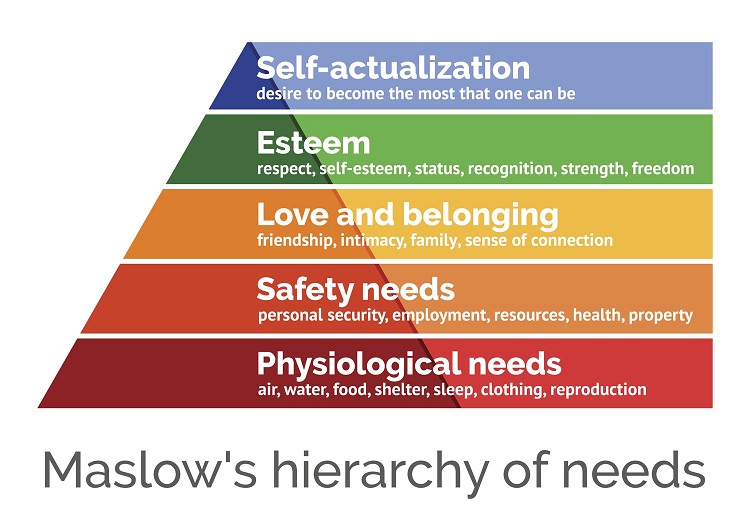Workplace Stress and Maslow’s Hierarchy of Needs

Workplace Stress and Maslow’s Hierarchy of Needs
With the Mentally Safe Work Conference on the horizon, Gordon Anderson, Hasmate Ltd revisits a 2011 article to provide us with ‘food for thought’ around looking after ourselves and employees.
Mental health and health and safety
With mental health now recognised as a prime workplace and health issue, I thought it would be pertinent to revisit this subject that is ever increasing to make the headlines. 47% of New Zealanders will experience a mental disorder such as depression, anxiety, or an alcohol or drug addiction, at some time in their lives.
The management of employees’ health (physical and mental) in the workplace is not just a moral or ethical responsibility – it is still a responsibility under the Health and Safety at Work Act 2015 to manage the health, including the mental wellbeing, of your employees while at work.
How is this defined in current law?
Although the Health and Safety at Work Act 2015 is not so specific, here is a starting point.
Section 36 (g) That the health of workers and the conditions at the workplace are monitored for the purpose of preventing injury or illness of workers arising from the conduct of the business or undertaking. Workplace stress is recognised as a health-related issue.
The responsibility to manage workplace stress and mental health is still a responsibility of the PCBU. This should be a process of evaluating the workload, and exposure to excessive workload/s or situations that may put employees at risk and undertaking a risk assessment management approach to that exposure.
I can relate to this from personal experience. Prior to starting my own business in 1993, I was employed by a corporate where the demands and work pressure were high and stressful. I eventually got to a stage where I knew I needed help – however this was not taken seriously by senior management. As a result, I was inflicted by diagnosed occupational stress disorder resulting in what was termed occupational asthma, and after 30 years, I am still having to take medication every day to manage this. Add to this the impact it had on not only myself, but also my extended family, both emotionally and physically, it has not been a pleasant journey or place to be in.
Maslow’s hierarchy of needs
For an understanding of how and why people act in different ways lets revisit a 1940’s human management theoryMaslow’s Hierarchy of Needs. This theory is as relevant today as it was last century, after all, human evolution has not changed that much since the 1940’s.
Understanding this theory will give you an idea of not only where you sit with your needs or level but may provide an understanding of where your employees or work colleagues are and why they act the way they do if their lives go sour. This can become evident especially when performance is slipping or accidents, absenteeism and other out of the normal personnel events are happening.
Maslow’s theory set out as a pyramid includes five predetermined levels of priority.
Starting at level one, ‘biological and physiological needs’ is a given of the basics of human needs and then rising in priority, culminating in self-actualisation, or reaching the top of your personal mountain or achievement.
Levels
- Biological and physiological. The most obvious needs for survival itself (‘base camp’) air, food, drink, shelter, warmth, sex, sleep.
- Safety needs. Protection from the elements, security, law and order, stability = your home.
- Belonging and love. Family, work groups, affection, relationships etc= acceptance
- Esteem. Self-esteem, achievement, independence, status, dominance, prestige.
- Self- actualisation. You are at the top of the tree, you are realising your personal potential, self-fulfilment. Seeking personal growth and peak performance.
Maslow’s Hierarchy of Needs states that:
- We must satisfy each need in turn, starting with level 1 – ‘base camp’.
- Only when the biological and physiological needs along with emotional and well-being are satisfied and met, are you concerned with the next level of needs of influence (you do not climb any higher until your mind set and physical and emotional needs are met).
- Conversely, if the things that satisfy our lower order needs are threatened or going astray, ie work overload, health, marriage, we are no longer concerned about the maintenance of our higher order needs (you revert downwards to the next level or your basic survival instincts).
For the business owner or manager
In the workplace, if the performance of yourself or others is slipping, mannerisms, unusual anger, or behaviour, then, as a business owner or manager investigate to find out why and what is behind the shift or change.
By understanding Maslow’s five level processes, you can then understand how or why some managers or employees can change from a good employee to a poor performing employee when they shift from the ‘norm’. Start to look for the signs and behind the scenes.
It may be work related, their marriage, financial, health, family, drug or alcohol use that may be a precursor to their high levels of stress and very different behaviour from the norm. All these factors do have an impact on the individual and no one is immune from it.
Remember – if it is a work-related issue, or caused by overload or work-related stress, as an employer you have a legal obligation to identify it, establish the level of the risk, communicate, and manage it for the health and welfare of your employees, yourself, your family and for the benefit of your business.
Gordon Anderson, Managing Director, Hasmate Ltd Napier